Apple iPad 2 Preview
by Anand Lal Shimpi, Brian Klug & Vivek Gowri on March 12, 2011 6:01 AM ESTWiFi + AT&T 3G
The iPad 2 uses what boils down to same exact same 802.11a/b/g/n WiFi + Bluetooth 2.1 EDR solution as its predecessor, the BCM4329. The iPad 2 maintains full 5 GHz (802.11a/n) support, just like the previous iPad, and also negotiates a transmit rate of 65 megabits/s just like nearly all single stream 802.11n mobile devices we've seen thus far. Close to the AP and within good coverage radius, the experience is exactly the same as its predecessor. Best case throughput is virtually identical between the two generations.
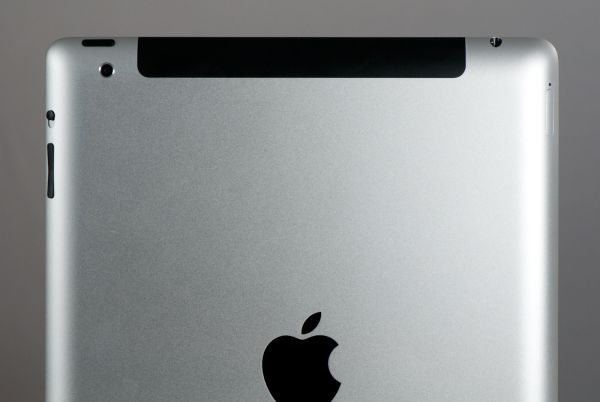
The black plastic strip at the top still is an RF window for cellular connectivity. The strip is black even if your iPad is white, which is a bit puzzling.
That said, thus far we've noticed that wireless range on the iPad 2 is measurably less than the iPad 1. It's not a terribly huge difference, but definitely noticeable as you drop one or two bars of WiFi signal strength. Throughput goes way down compared to the previous generation. We're still testing everything, but it's just not quite as good. No doubt the iPad 2 has a completely different RF design than the original iPad which accounts for this difference.
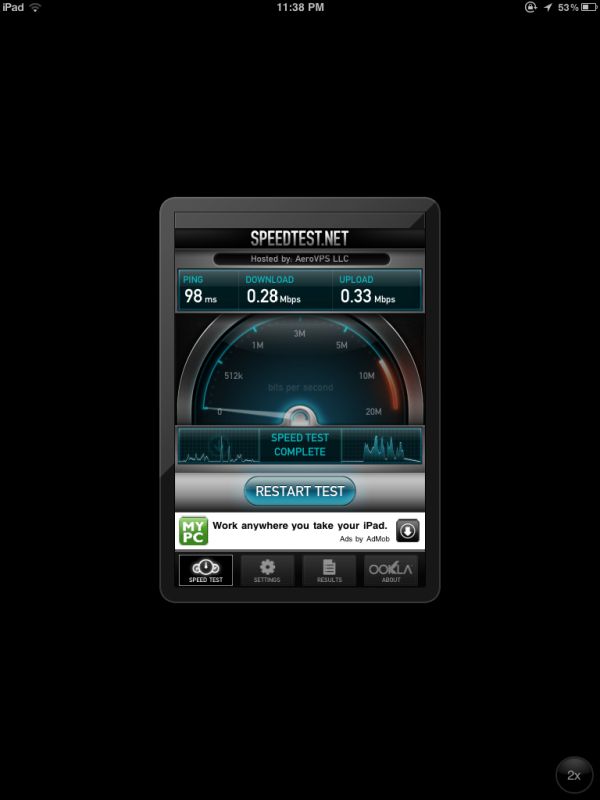
Left: iPad 1 across the street, Right: iPad 2 same location
We've got both an AT&T, Verizon, and WiFi model between the three of us (Anand, Vivek, and myself) and will do the usual due diligence testing cellular connectivity.
Following the rather controversial and inexplicable crippling of HSUPA on the Motorola Atrix and Inspire 4G, the first thing I did with the iPad 2 is run a speedtest. HSUPA is definitely enabled on this device and working just fine. Throughput is where it should be in the best and worst signal cases so far, topping out at around 6 Mbps down, 1.5 Mbps up at my house within line of sight to an AT&T Node B. Apparently AT&T is inexplicably only concerned with Android devices crippling the network with upstream traffic.
AT&T iPad 2 Cellular Data Throughput
Anand did some initial testing on the Verizon iPad 2 and averaged 1.54 Mbps down, 0.72 Mbps up in testing with good signal strength, which seems about average. Max speeds we've seen on Verizon so far are 1.64 Mbps down and 0.82 Mbps up.
| iPad 2 - Network Support | |||||
| Verizon Version - CDMA2000-1xEV-DO | 800 / 1900 MHz | ||||
| AT&T Version - Quad-Band UMTS + HSDPA/HSUPA | 850 / 900 / 1900 / 2100 MHz | ||||
| AT&T Version - Quad-Band GSM/EDGE | 850 / 900 / 1800 / 1900 MHz | ||||
| Baseband Hardware | Unknown - Possibly MDM6x00 | ||||
Nobody has disassembled an iPad 2 with 3G connectivity from either Verizon or AT&T, but it seems likely that the two would both leverage a Qualcomm MDM6x00 baseband (where x is 6 for CDMA2000/EV-DO + UMTS/GSM support, 2 for only UMTS/GSM) considering its use in the Verizon iPhone 4.
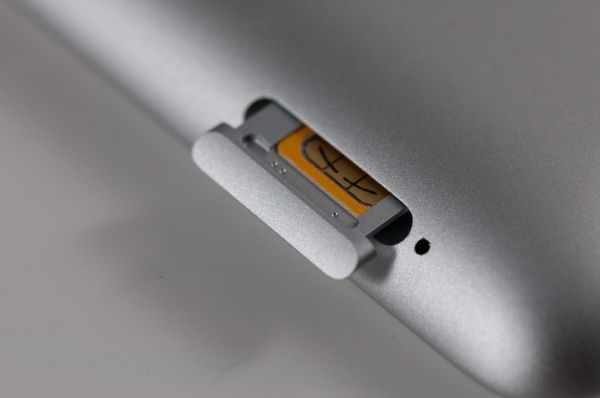 MicroSIM peeking out of the side on the AT&T version. Also yes, it does come with a SIM ejector tool.
MicroSIM peeking out of the side on the AT&T version. Also yes, it does come with a SIM ejector tool.
Interestingly enough the AT&T model with FCC ID BCG1396 has UMTS/HSDPA/HSUPA support for quad-band UMTS and GSM. The Verizon FCC ID BCG1397 has reports for just cellular and PCS - 850 and 1900 again but CDMA nomenclature.


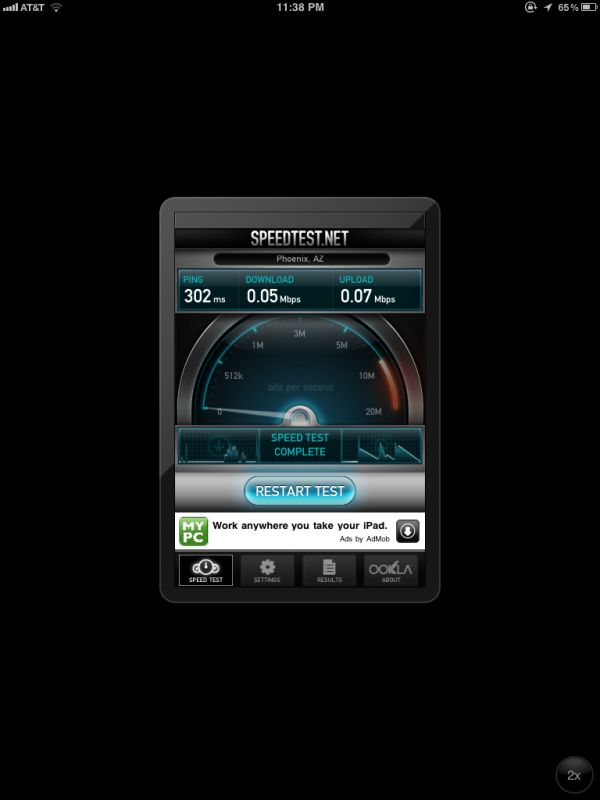
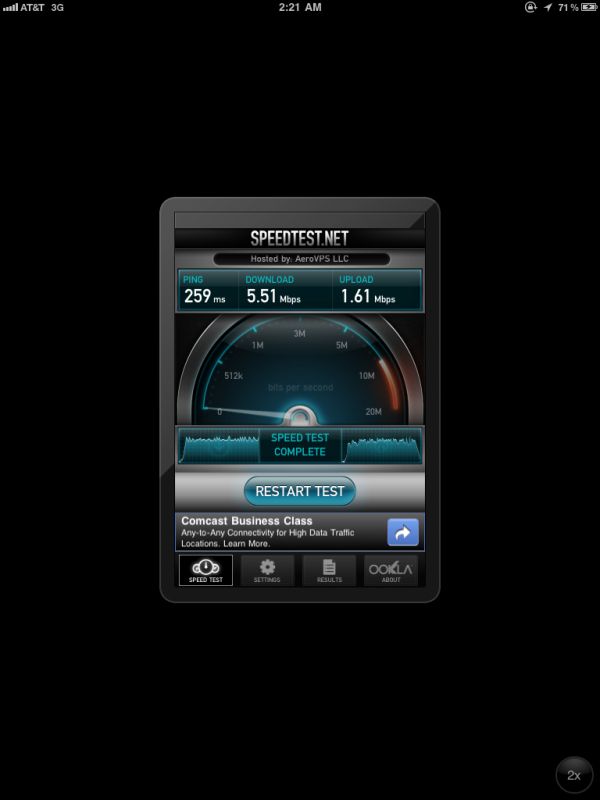








82 Comments
View All Comments
Seurahepo - Sunday, March 13, 2011 - link
Is there a problem with the comment system? This comment looks like it was from March 2010. :)Joking aside, I am not sure what you are comparing iPad with, but it is hard to see how it would be huge and bulky. Sure it is bigger than your cell phone, but it also gives you about seven times the screen area (comparing iPhone and iPad), which makes a big difference to how apps should make the layout and how gestures work.
You claim people purchasing iPads (and other tablets?) are stupid, which would be the better choice for them? Mobile phone? netbook? laptop? something else? Another tablet, just not from Apple?
Web browsing is one thing you can do with it, you can do your mail, you can play games etc. But the main thing is *apps*, which app is the killer app for you, I cannot know, but there are 65 thousand already out there and the number is growing. iPad like tablets is the future platform for a big group for apps. Not Windows PC or even Macs, those are the dinosaurs of the past, post PC-era is here.
vision33r - Saturday, March 12, 2011 - link
If it's pointless device to you then why do you bother reading this article and make complaints about it?Seems you got some anxiety or insecurities to work on.
Same question can be asked about anything in this world.
What's the point with a convertible sports car?
Why do some people use a briefcase and not a backpack?
sean.crees - Sunday, March 13, 2011 - link
Majority of my time lately online seems to be reading web pages, watching video's, checking email, listening to music.All of which is much more convenient on an Ipad. Notebooks are bulky to walk around with because of the attached keyboard. Smartphones are too small to clearly see what it is your doing. Smartphones may "work", but tablets make it more enjoyable.
So what i end up with is the freedom of a smartphone with the display size of a small notebook. Best of both worlds IMO.
I may not be able to put it in my pocket, but at least i don't need a chair to use it like a laptop. Have you ever tried using a laptop in your hands while you walk around with it? Its incredibly difficult.
While the ipad may not fit in my pocket, its small and light enough that i wouldn't mind just holding it in my hands as i walk around, or tossing it in a backpack/purse, or perhaps even getting a larger pocket sewn into the inside pocket of a jacket.
NCM - Monday, March 14, 2011 - link
Over 15 million buyers seem to have figured out the point of the original iPad, enough to pay $500 or more for one. Rather a lot to ascribe to mass hysteria. Maybe it's something in the water?Or did we somehow miss the news reports about hordes of disgruntled buyers demanding refunds for their "pointless" devices?
nitrousoxide - Saturday, March 12, 2011 - link
Please explain me this: In your XOOM review, it loads AnandTech.com in 603.1ms while it takes 2000+ms in this preview. Have you changed your benchmark suite?Anyway I believe that Google's Android is simply a waste of hardware power. It's a poorly optimized OS, no matter Gingerbread or Honeycomb. The only way for it to keep up with iOS or Windows Phone is using superfast chips but when that hardware advantage is gone, it stands no chance.
Seurahepo - Sunday, March 13, 2011 - link
Yes, they changed back to hand timing, because the results from the Android browser were strange.name99 - Saturday, March 12, 2011 - link
"The iPad 2 maintains full 5 GHz (802.11a/n) support, "This is not so. As far as I can tell, for example, 5GHz 40MHz channels are not supported. This is the big one. I don't have the kit to test it, but it would not surprise me short guard intervals and some of the other optional protocol niceties that buy you a few percent (to, sometimes many 10s of percent) here and there are also not supported.
More generally, might I make a plea that you institute some sort of standardized benchmark for testing the quality of WiFi (and 3G, though for iPad I care about this less) implementations?
The reason I ask is that
- for reasons I don't understand Apple (quietly and behind the scenes) seems to keep pushing to always have better wireless kit than the competition (eg 3 active antennas in the newest MacBook Pros and Airport Base Station) while the competition lag BUT
- the quality of wireless in these devices is an easy target for improvement right now, adding in more antennas and smarter decoding algorithms.
In other words, it seems to me that an OBVIOUS way for the next great tablet to differentiate itself from iPad2 is through having multiple antennas (both WiFi and 3G) hooked up to competent firmware and OS code, such that it could achieve double or better WiFi bandwidth, and a much more robust WiFi and 3G experience.
It would be nice, if this happens, for AnandTech to be able to verify the truth of the (doubtless exaggerated) statements the marketers will make, and more generally to play the same role here that it has played in SSDs in just pushing awareness of the state of the art forward and not allowing manufacturers to get lazy. (I'd regard, for example, Apple's unwillingness to boost the WiFi here over iPad1 as an example of being lazy because they can get away with it. They have no competition in the tablet space, and it's not something reviewers look at carefully and complain about.)
Seurahepo - Sunday, March 13, 2011 - link
While making a better wifi implementation may seem like an obvious way of differentiating from iPad it is far from it. Better networking implementation is very hard to market for the general population. The only viable way seems to be marketing by buzzword, marketing the same buzzword with "better implementation" will be hard.For the non-geek the speed is often more than enough, they are used to the fact that computers take their time. And even if they found it to be slow, they would not know what is the reason.
Brian Klug - Monday, March 14, 2011 - link
So the iPad 1 and 2 both only support the long guard interval (65 Mbps) MCS on both 2.4 and 5 GHz channels, with only 20 MHz support.I consider this "full" mobile support only because the majority of "802.11n" mobile devices do the same thing - 65 Mbps, or in rare circumstances short guard interval 72 Mbps.
Keep in mind, the iPad 1 already was the differentiating product, as it was the first smartphone/tablet that came with 5 GHz support at all. The myTouch 4G and Galaxy S 4G both also have 802.11a/n support with 72 Mbps.
I've definitely been testing/pushing for more/better antenna and connectivity, and it's interesting that Apple chose to essentially keep the same WiFi stack as they had in the previous version. That said, baseband has definitely improved ;)
-Brian
btdvox - Saturday, March 12, 2011 - link
I disagree with your comment on the White iPad, I had a choice between the White 32 and Black 32, and after seeing demo models of both yesterday, it's clear the White looks very cheap, the Service Rep told me it's actually not covered with glass but rather the components of the white macbook and can be prone to staining.Sure it doesn't show finger prints, but watch any movies, and websites that use dark schemes (Which every movie does and most websites do), even the top bar is black (status bar), and with a black bezel, these components all "seam" together, and even the hardware (things like the light sensor, camera etc, are barely visible).
With the White bezel all these components make the ipad less seamless and I thought the display on the white looked worse, simply because of it's bezel.
The same goes for TV's, would you rather watch a movie on a TV with a white or grey bezel or a glossy black one? I'll always choose glossy blacks, it makes the display look better.
Still pictures suck on the ipad 2, just like they do on the ipod gen 4 but Video is really good, on par with iphone 4! Sucks that they didn't spend the same components on the iPad 2 camera, wish they did!! No autofocus kind of sucks too!